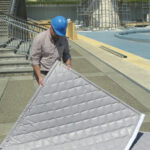Soundproofing
Sound insulation is the process of soundproofing an enclosed space, such as a room. This type of insulating activity is usually employed when there is a need to keep sound from filtering into or out of the space. Sound insulation techniques are often used in business settings, as well as in multi-family dwellings like duplexes and apartment buildings.
In order to prevent background noise from interfering with the recording process, singers and musicians create their vocal and instrumental tracks in a soundproof recording booth. Because the booth prohibits the introduction of sounds from outside the space, there is nothing present to distort or interfere with the quality of the recording. The audio tracks containing vocal performances and the various music tracks are captured exactly as the performers hear them.
In living space, sound insulation normally involves the installation of insulation in walls, under floors, and above ceilings. This can be especially important in apartment buildings and other structures where people live in close proximity. The inclusion of the insulation between apartments to the side, above, and below helps to ensure all the residents enjoy a measure of peace and quiet, even when others in the building are playing music or having a party.
In an office setting, it is not unusual for the individual offices of managers to be insulated for privacy. This makes it less likely for confidential discussions between an employee and a manager to be overheard by others working elsewhere on the floor or near the door of the manager’s office. In like manner, conference rooms are often treated to a sound insulation treatment, ensuring discussions taking place within that space are not overheard by others in the immediate vicinity.
Soundproofing insulation is a man-made material that is designed to absorb sound waves. This type of insulation is commonly installed in recording studios, meeting rooms, and concert halls. The purpose of soundproofing insulation is to improve the enjoyment of the sound in the initial room through the removal of external noises and to eliminate the traveling of the sound waves outside the room.
Soundproofing foam is a building material used to control the transmission and absorption of sound. This material can be used to achieve two distinct goals when it comes to sound control. First, it is used in homes and commercial buildings to block sound from the outdoors, keeping the interior of the space quieter for the occupants. Soundproofing foam can also be used to absorb noises in recording studios or theaters, which reduces echo and improves the quality of the sounds.
To understand how different types of soundproofing foam can be used, one must first understand how sound waves and noise levels are measured. The ability of an object to block sound is measured by its Sound Transmission Coefficient (STC) rating, which can range from 0 to 100. A wall with an STC rating of 50, for example, means that noise levels on one side of the wall are 50 decibels higher than on the other side. Sound absorption is measured using the Noise Reduction Coefficient (NRC), which generally falls between 0 and 1. This number shows the amount of sound absorbed by an object, and the higher the NRC value, the more noise is absorbed
A soundproof ceiling is a ceiling that has been designed to cut down on the noise that is transferred from overhead to the area below. A soundproof ceiling is a nice addition for people who live in apartments, but, surprisingly, many people who live in private homes are also interested in soundproofing their ceilings.
A soundproof door is a door that has been designed or retrofitted to cut out as much external noise as possible. However, a soundproof door is also very dependent on a well-designed frame, or sound can leak around the edges of the frame. Unwanted noise can also filter through walls and windows, which are an important consideration for people who are attempting to soundproof a room or building.
There are a variety of situations in which a soundproof door can be useful. Musicians and recording studios rely on such doors to keep sounds from getting out, both for the comfort of the neighbors and for the benefit of other musicians and recording facilities that could be compromised by sound leakage. Soundproof doors are also used to seal noisy rooms like boiler rooms and entrances to factory floors. People can also utilize soundproof doors to keep unwanted sounds out of their homes.

